Complete Guide to Fort Smith National Historic Site in Arkansas, including history, things to do, directions, hours, and so much more!
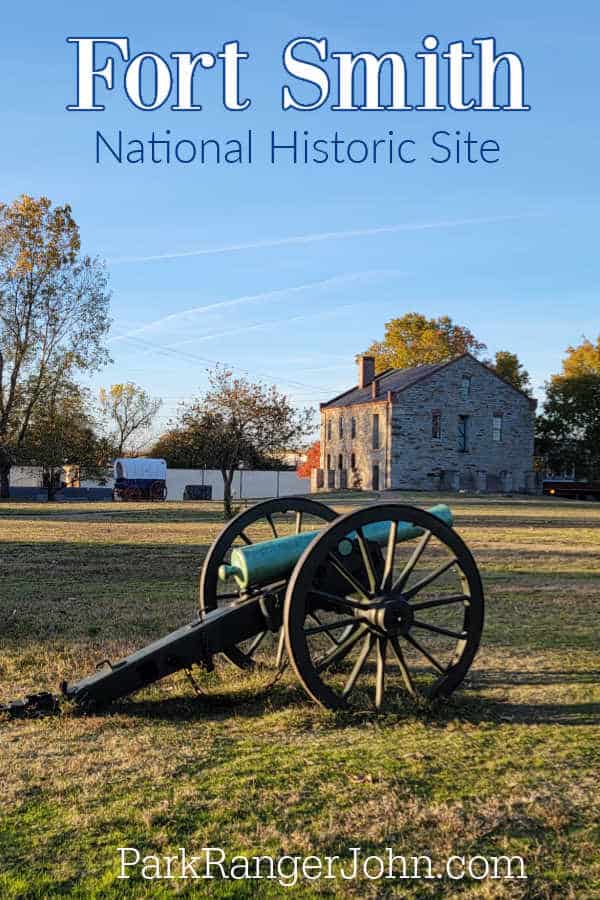
TL;DR Don’t have time to read the full article? Here are my top finds:
🏨Hotels and Vacation Rentals
📍Tours
🐻 Save time! Buy your National Park Pass before your trip
Fort Smith National Historic Site
Fort Smith National Historic Site is located in west-central Arkansas within the town of Fort Smith. The park is open year-round and offers the opportunity to tour the foundations of the original fort.
From the establishment of the first Fort Smith on December 25, 1817, to the final days of Judge Isaac C. Parker's jurisdiction over Indian Territory in 1896, Fort Smith National Historic Site preserves almost 80 years of significant history.
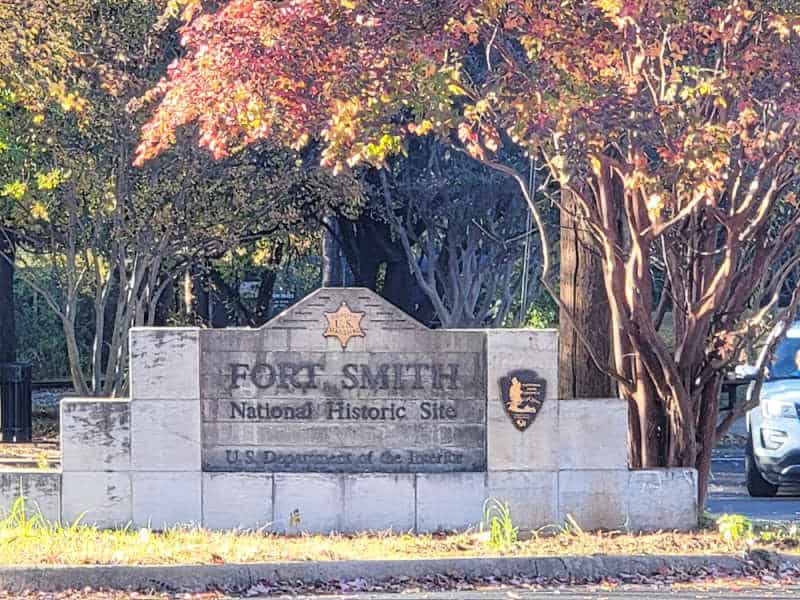
Fort Smith National Historic Site Entrance Fee
Fort Smith National Historic Site does not charge an entrance fee!
Learn more about National Park Passes for parks that have an entrance fee.
$80.00 - For the America the Beautiful/National Park Pass. The pass covers entrance fees to all US National Park Sites and over 2,000 Federal Recreation Fee Sites for an entire year and covers everyone in the car for per-vehicle sites and up to 4 adults for per-person sites.

Buy your pass at this link, and REI will donate 10% of pass proceeds to the National Forest Foundation, National Park Foundation, and the U.S. Endowment for Forestry & Communities.
National Park Free Entrance Days -Mark your calendars with the five free entrance days the National Park Service offers annually.
About Fort Smith National Historic Site
If you want to experience the real “Old West,” then a trip to Fort Smith National Historic Site is in store. The site of two important frontier forts, Fort Smith, is perhaps best known as the headquarters of the “Hanging Judge” of the Old West.
It was here that U.S. District Judge Isaac C. Parker sent more than 70 outlaws to the gallows during the rough and tumble days following the Civil War. Parker’s deputy marshals provided the inspiration for such Hollywood classics as “True Grit,” “Rooster Cogburn” and “Hang Em High.”
Ironically, Parker opposed the death penalty, but in cases of murder and rape, U.S. law allowed him only one sentence – death.
The National Historic Site features ruins and buildings from the original fort, the notorious “Hell on the Border” jail, Parker’s courtroom, exhibits on the deputy marshals and outlaws of Fort Smith, and the reconstructed gallows where so many outlaws met their fates.
The 1803 Louisiana Purchase marked the greatest expansion of the United States, but there was a caveat to white settlement. All the territory was occupied by Native Americans and labeled "Indian Territory" by the government.
Tribes were already being pushed around and relocated. The Cherokee arrived in the Arkansas River Valley and clashed with native residents the Osage. Washington responded with the creation of Fort Smith to keep the peace.
The site of the first fort, and the existing second fort, have been preserved at Fort Smith National Historic Site in Arkansas. A city bearing the same name developed outside the fort and the park is located in the downtown area near Fort Smith Museum of History and Fort Smith Trolley Museum. What was once a wild-west outpost is now citified.
The original fort was built in 1817, at Belle Point, a strategic spot overlooking the Arkansas and Ploteau rivers.
The fort was abandoned in 1824, as the army moved further west in its operations only to return in 1836, to deliver provisions to relocating tribes on the infamous "Trail of Tears" in which 10,000 members of the Cherokee, Seminole, Creek, Choctaw, and Chickasaw perished on the forced march.
The log buildings disintegrated over time and stone foundations disappeared beneath the soil. That foundation was uncovered in 1958.
Today, visitors can take the scenic river trail and see the outlines of where the first fort stood and the flagpole site. Markers provide information. There really is not much to see and imagination is required to envision a bustling fort.
However, the scenery is pleasant and there are fine river views offering a glimpse to a past when all was wild. Look hard to see geese, turtles, and other wildlife.
The second fort was built further inland in 1838, in response to the fear of Indian uprisings. This time the fort was constructed of stone to withstand heavy attack. War with Indian never materialized but due to growing expansion, Fort Smith became an important supply depot thanks to close proximity to river steamboats hauling goods.
The town grew and prospered. During the Civil War, the fort served as a supply depot for both Union and Confederate sides in war divided Arkansas.
The military vacated the fort in 1871. The facility did not remain vacant for long. The federal court for the western district of Arkansas occupied the large barracks building from 1872 to 1896 and justice was administered over Indian Territory.
This was headquarters for the U.S. Marshal's service. The basement jail enjoyed a brutal reputation. The courtroom was presided over by "The Hanging Judge," Isaac C. Parker.
The converted barracks to the courthouse is a dignified well-preserved structure.
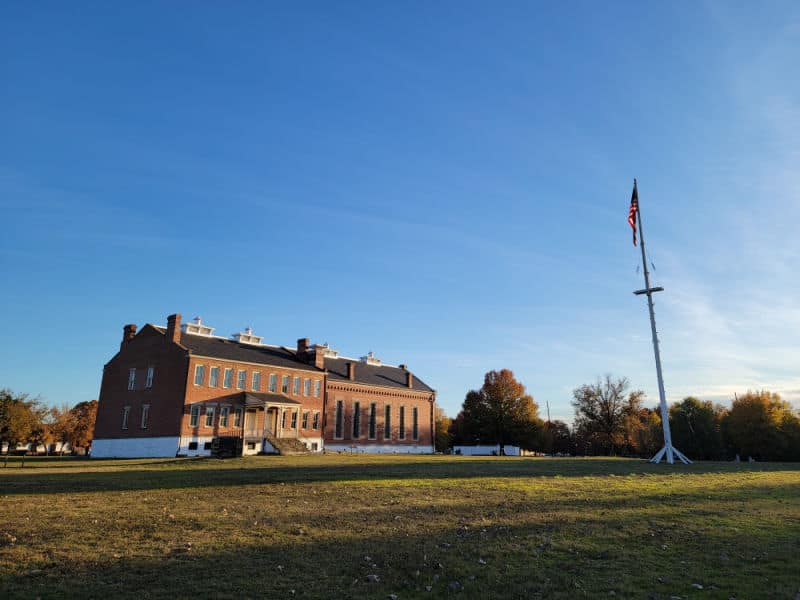
Is Fort Smith National Historic Site worth visiting?
Yes, this National Historic Site has really interesting interpretive displays, a great Junior Ranger program, and tons of historic buildings and a large area to wander the grounds of the park.
We found the displays and history really interesting and enjoyed our time in the park.
History of Fort Smith National Historic Site
Fort Smith National Historic Site interprets and preserves the history of life on the Western Frontier. The site is part of the Trail of Tears National Historic Trail and is home to two frontier forts.
Fort Smith National Historic Site also preserves the ground where many infamous outlaws of the Wild West met their end at the gallows.
The First Fort at Fort Smith National Historic Site
The first Fort Smith was built in 1817, where the Arkansas and Poteau rivers meet at a site known as Belle Point. The first Fort Smith was established by the U.S. military as a permanent outpost to keep the peace in the region.
Arkansas was home to the Native Nation tribe of the Osage. In the 1800s, the Cherokee began arriving in the region after being pushed from their homelands by white settlers. The first Fort Smith was under the command of Major William Bradford and operated until it was abandoned in 1824.
The first Fort Smith was a log structure that eventually rotted and became uninhabitable. Today you can see the foundations of the first Fort Smith uncovered in the 1950s.
Fort Smith and the Trail of Tears
Fort Smith National Historic Site forms part of the Trail of Tears National Historic Trail. The Trail of Tears is the name given to the collection of routes taken by the Cherokee Nation on their forced relocation to Indian Territory in Oklahoma.
It was not just the Cherokee who were forcibly removed from their homelands, but the “Five Civilized Tribes,” too. These were the Cherokee, Muskogee, Seminole, Chickasaw, and Choctaw. The U.S government authorized the forced relocation of the five Native Nations tribes in 1830.
Many Cherokee died on the Trail of Tears due to the terrible conditions they had to endure, and thousands died from the forced relocation. The Cherokee and Choctaw stopped at what is now the Fort Smith National Historic Site on their way to Oklahoma.
To commemorate and reflect on the tragedy, the Fort Smith National Historic Site has a walk overlooking the Arkansas River.
The Second Fort Smith
The second Fort Smith was built in 1838, shortly after Arkansas became a state. Many on the Frontier feared an attack from Native Nations in the region. The second Fort Smith was home to a commissary and an enlisted men's barracks.
Because of the fort's position along the Arkansas River, it was used as a supply depot from 1846 when the Mexican-American War broke out. The fort continued to be a major supply depot throughout the westward expansion.
When the American Civil War began in April 1861, Fort Smith was evacuated by the U.S Army for fear Arkansas would soon join the Confederacy. One month after the evacuation, Arkansas seceded from the Union. Fort Smith became a Confederate military outpost during the Civil War until it was retaken by the Union in 1863.
After the Civil War ended, the Fort Smith Council was held, during which representatives from 15 Native Nations tribes met with the U.S government. Even though many Native Nations' tribes fought alongside the Union, they received the same treatment as the defeated Confederates.
Justice on the Frontier at Fort Smith
Fort Smith was abandoned by the U.S. Army in 1871. Fort Smith was transformed into a courthouse in 1872. The United States District Court for the Western District of Arkansas was housed at Fort Smith from 1872 to 1896.
The court had jurisdiction over not just Western Arkansas but Indian Territory too. Judge Isaac C. Parker presided over the court from 1875 until 1896. The district was the largest and most deadly court district. Parker reformed criminal justice while presiding over the court and introduced the idea of rehabilitating criminals.
Despite his efforts, he was nicknamed the ‘Hanging Judge’ by Hollywood, as he sentenced 160 men to death and is remembered mainly for the mass executions he presided over.
Of the 160, 86 of the sentences resulted in executions. The executions were performed at the gallows situated at the site. Although the original gallows did not survive, a reconstruction now stands in its place.
The jail for those awaiting trial was in the courthouse's basement. The jail consisted of two cells, in which up to 100 men were kept. There was no proper sanitation, and no light or air flow except from two underground windows. The conditions were so terrible that the jail earned the name 'hell on the border.'
A thriving town developed around the fort, and in 1896 the courthouse was moved to the town of Fort Smith. Fort Smith became a National Historic Landmark in 1961.
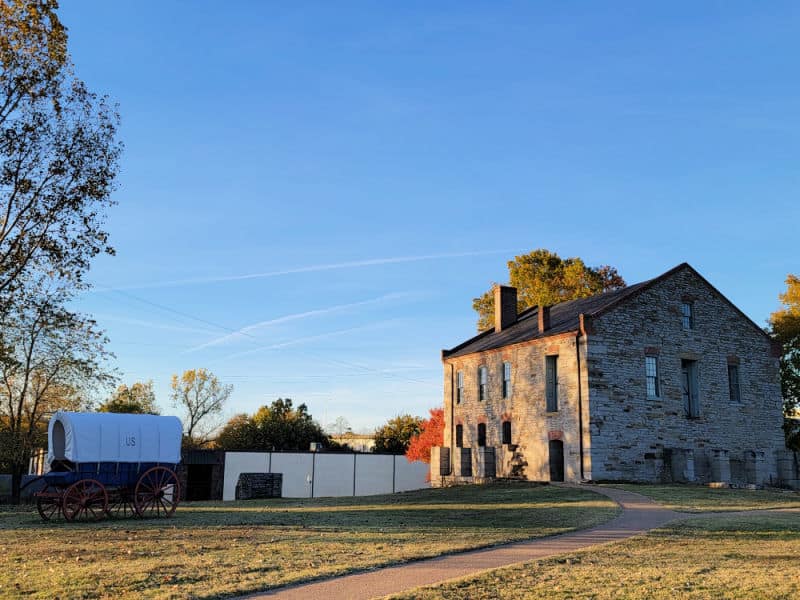
Things to know before your visit
Time Zone
Central Time Zone
Pets
Pets are welcome at the park. Always keep your dog on a leash and under control.
Cell Service
Cellular access is available for most users
Park Hours
The park is open daily from 9 AM to 5 PM.
The visitor center is closed on New Year's Day, Thanksgiving Day, and Christmas Day.
Wi-Fi
Free Wi-Fi is available inside the Visitor Center
Insect Repellent
Insect repellent is always a great idea when outdoors, especially if you are around any body of water.
We use Permethrin Spray on our clothes before our park trips.
Water Bottle
Make sure to bring your own water bottle and plenty of water with you. Plastic water bottles are not sold in the park.
Parking
The parking lot is located at 3rd Street and Garland Avenue.
The parking lot can fit large RVs and buses.
Food/Restaurants
There are no restaurants within the park. There are restaurants nearby.
Gas
There are no gas stations within the park. There are some nearby.
Drones
Drones are not permitted within National Park Sites.
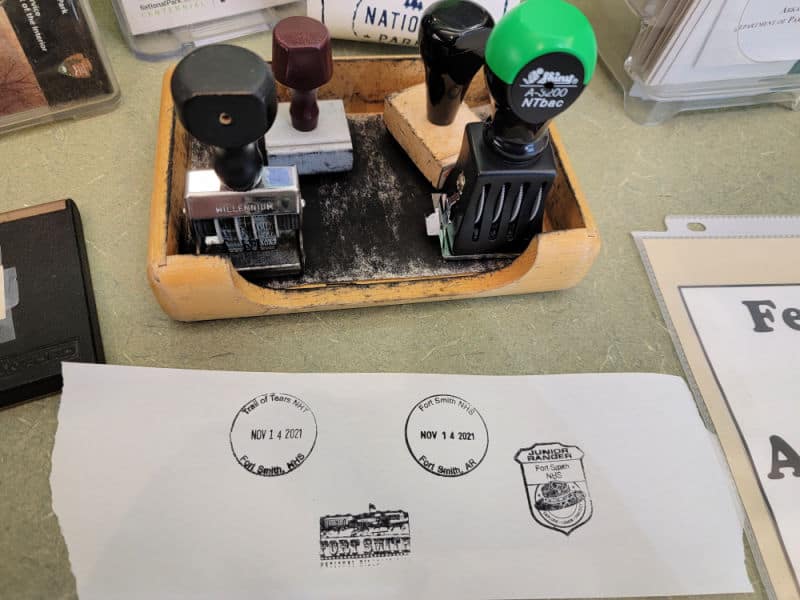
National Park Passport Stamps
National Park Passport Stamps can be found within the visitor center.
The Fort Smith Passport Stamp is part of the 2001 Passport Stamp Set.
We found the following stamps while at the park:
- Fort Smith NHS, Fort Smith, AR
- Trail of Tears NHT, Fort Smith NHS
- Junior Ranger Stamp
We like to use these circle stickers for park stamps so we don't have to bring our passport book with us on every trip.
The National Park Passport Book program is a great way to document all of the parks you have visitied.
You can get Passport Stickers and Annual Stamp Sets to help enhance your Passport Book.
Electric Vehicle Charging
The city of Fort Smith in Arkansas has 39 public charging stations.
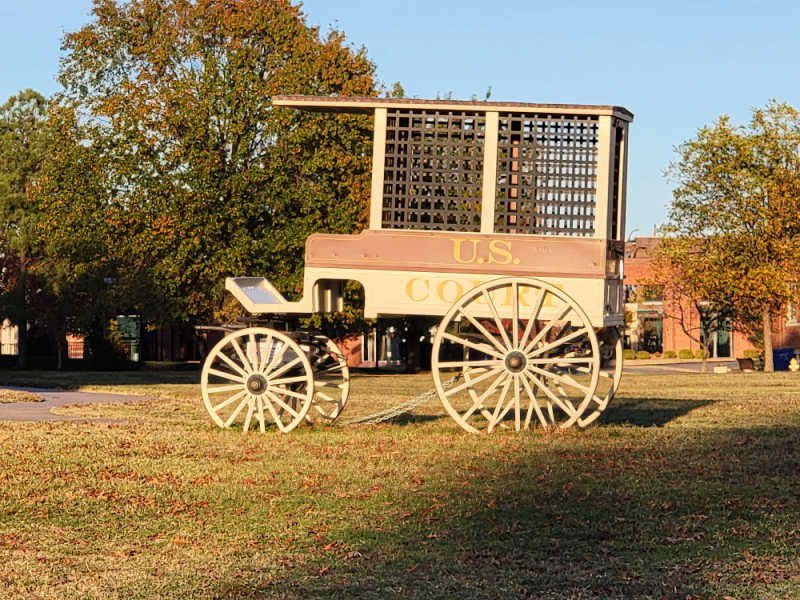
Details about Fort Smith National Historic Site
Size - 37 acres
Check out how the park compares to other National Parks by Size.
Date Established
September 13, 1961
Visitation
In 2021, Fort Smith NHS had 99,854 park visitors.
In 2020, Fort Smith NHS had 67,574 park visitors.
In 2019, Fort Smith NHS had 125,500 park visitors.
Learn more about the most visited and least visited National Parks in the US
National Park Address
301 Parker Ave, Fort Smith, Arkansas 72901
National Park Map
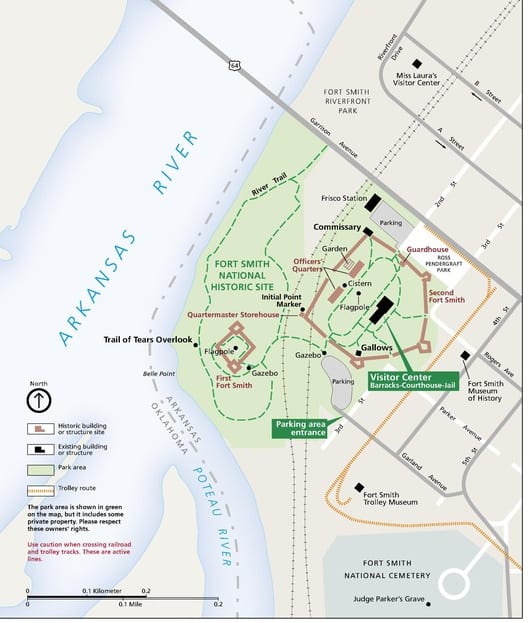
Where is Fort Smith National Historic Site?
Fort Smith National Historic Site is located in Fort Smith, Arkansas, along the Arkansas River.
Estimated distance from major cities nearby
- Tulsa, OK - 150 miles
- Oklahoma City, OK - 200 miles
- Plano, TX - 250 miles
- Dallas, TX - 270 miles
- Wichita, KS - 310 miles
- Arlington, TX - 280 miles
- Fort Worth, TX - 290 miles
- Dallas, TX - 277 miles
- Memphis, TN - 290 miles
- Kansas City, MO - 300 miles
- Austin, TX - 472 miles
Estimated Distance from nearby National Park
Hot Springs National Park - 120 miles
Mammoth Cave National Park - 587 miles
Gateway Arch National Park - 422 miles
Indiana Dunes National Park - 736 miles
Great Smoky Mountains National Park - 695 miles
Where is the National Park Visitor Center?
The Visitor Center is located in the historic barracks courthouse jail building.
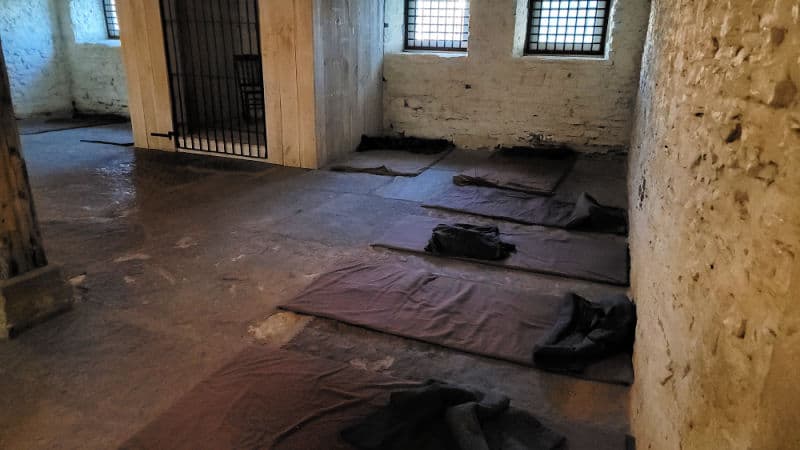
Getting to Fort Smith National Historic Site
Closest Airports
- Fort Smith Regional Airport - 6 miles
International Airports
- Tulsa International Airport - 145 miles
Regional Airports
- Muskogee-Davis Regional Airport - 85 miles
- Northwest Arkansas Regional Airport - 90 miles
Driving Directions
From Interstate 40 Eastbound: Exit at Roland, and drive six miles on highway 64 to downtown Fort Smith. From Interstate 40 Westbound & from North I 540 & Fayetteville, take Interstate 40 westbound to I 540 south. Exit west on Rogers Ave. and continue to downtown. In the downtown area: On Rogers or Garrison Ave turn south at 4th St. Turn right onto Garland Ave. At the end of the next block is the entrance to the main parking lot. Parking is also available on Third Street.
East-bound on Hwy 64 (Garrison Ave.)
- Turn right onto 4th St.
- Continue through the first stop sign (Rogers Ave) at second stop sign turn right on to Parker Avenue.
- Turn left on 3rd St and continue 1 block to our main parking lot on the right.
West bound on Rogers Ave
- Stay on Rogers to 4th St and turn left
- Turn right on Parker Ave
- Turn left on 3rd St and continue 1 block to our main parking lot on the right.
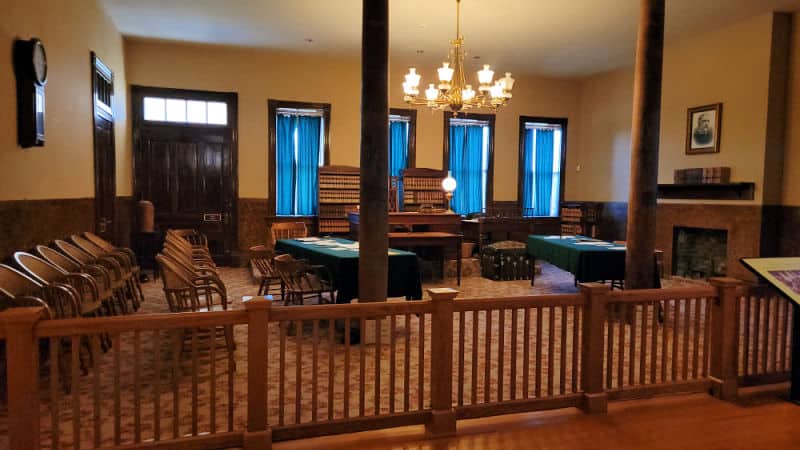
Best time to visit Fort Smith National Historic Site
The best time to visit Fort Smith National Historic Site is during the season that best suits your interests and preferences.
If you enjoy warm weather and outdoor activities, then summer might be the best time for you to visit. The park is open year-round, so you can visit any time that is convenient for you.
Weather and Seasons
The warmest weather is from June 3rd to September 18th, when the average daily high temperature exceeds 85 degrees.
The coldest weather is from November 27th to February 23rd, when the average daily high temperature is below 58 degrees.
The snowiest season usually occurs between December 13th to March 7th, with an average of at least 1 inch a month. February gets the most snow, with an average of 1.5 inches.
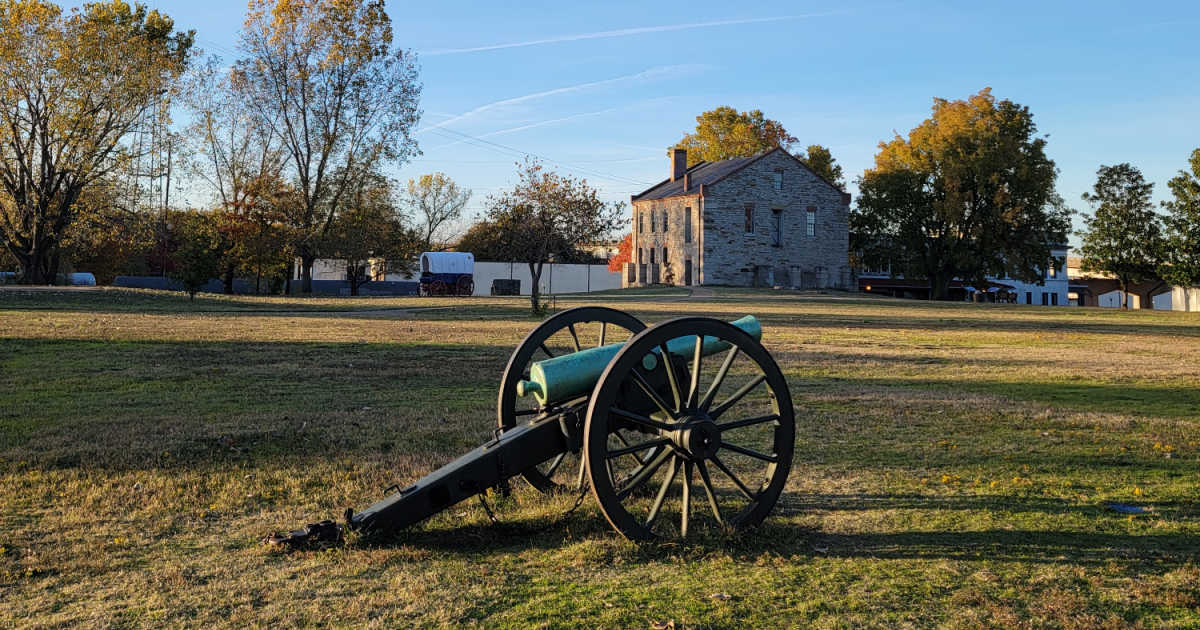
Best Things to Do in Fort Smith National Historic Site
We suggest planning a few hours to explore the park, wander the grounds, and finish the Junior Ranger program.
Visitor Center
The visitors center is located in the basement and the first thing to do is watch the orientation video in the mini-theater. Take note of the movie posters from films like "True Grit" and "Hang 'Em High" whose stories took place in the territory.
The jail does not look like much being a large empty space. The two cell areas once held up to 50 men each with disgusting sanitary conditions and emanating stench.
An original cell key is displayed. Artifacts such as old bottles and dominoes were unearthed during restoration.
The Fort Smith gallery relates its history from a frontier fort to a dispenser of justice. There are four small-scale models of the fort depicting its appearance at different times.
Excavation has yielded a treasure trove of artifacts. Broken pottery and bottles may just be debris but provide little clues as to what life was like then. Old dress buttons remain from army days. The Civil War is represented by weapons and diorama of the 1863 Battle at Devil's Backbone
A centerpiece is the recreated Judge Isaac Parker federal courthouse courtroom and office furnished with mostly reproductions. The ornate desk and chair were actually used by Parker in Washington, DC when serving in Congress. The bell, inkwell, and books are original. That is Judge Parker's walking stick and personal copy of the constitution.
Western enthusiasts will appreciate the U.S. Marshal's display including genuine badges and arrays of Colts, Winchesters, and other vintage guns.
Due to overcrowding and bad conditions, the jail was rebuilt to 72 cells on three tiers with the murderer's row on the bottom. Visitors are welcome to step inside a recreated "iron cage' and get a feel of being locked up.
The accompanying jail exhibits are the most interesting in the museum. The Belle Starr case contains a gold bracelet reputed to belong to the notorious female outlaw. There are numerous guns on display including those used by outlaws plus vintage handcuffs and leg irons.
George Maledon is a good story. He was the hangman who after retiring, toured with tent shows telling grisly tales and showing relics.
Cherokee Bill was an infamous outlaw and murderer and displayed is the rope that supposedly swung him.
Junior Ranger Program
The Junior Ranger program can be picked up from the visitor center.
The majority of the junior ranger program can be filled out within the visitor center. Plan time to find all of the answers.
Commissary Storehouse
There is still more to be explored on the grounds. The only other surviving structure is the commissary building storehouse. The large stone historic building is the oldest in Fort Smith. Visitors can venture inside which appears as a supply depot.
Elsewhere are foundations for the officer's quarters and women's jail and sites of the main guardhouse and officer's gardens.
The well site is designated by a marker and flagstaff rebuilt to the original height of 100 feet so the flag could be seen from a great distance.
The official entrance gate is a memorial built of stones from the original fort.

The Gallows
The gallows were torn down in 1897 and now a replica stands in its place. There is a list of the 86 men who met their demise at the end of a rope during the course of 23 years. On one occasion, six swung at the same time. An old jail wagon is parked there.
Fort Smith captures the flavor of the old west from wilderness Indian Territory to turn of the century civilization.
The outlaws depicted here are the real deal being dirty and mangy characters and not "clean" Hollywood stand-ins. Those traveling cross country on Interstate 40 should stop by the fort.
Hiking in Fort Smith National Historic Site
Always carry the 10 essentials for outdoor survival when exploring.
There is a short walk to Belle Point which is great for watching sunset over the Arkansas River.
Visitors can enjoy the walking trail along the Arkansas and Poteau Rivers to see the two rivers flow into each other.
There are also trails that wander through the grounds and surrounding river front area.
River Loop Trail
This 1 mile trail is a cement walkway that does cross three railroad tracks so please be careful. There are wayside exhibits along the trail.
Don't miss the Trail of Tears overlook.
Fort Smith Puzzling Adventure
⭐️ Rating: 4 out of 5 Stars | ⏳ Tour Length: 1-3 hours | 🥾Check Rates and Availability
Turn Fort Smith into a game while partaking on a 2-hour walking adventure. Your smartphone will act as your guide, while you solve clues and complete challenges around the city.
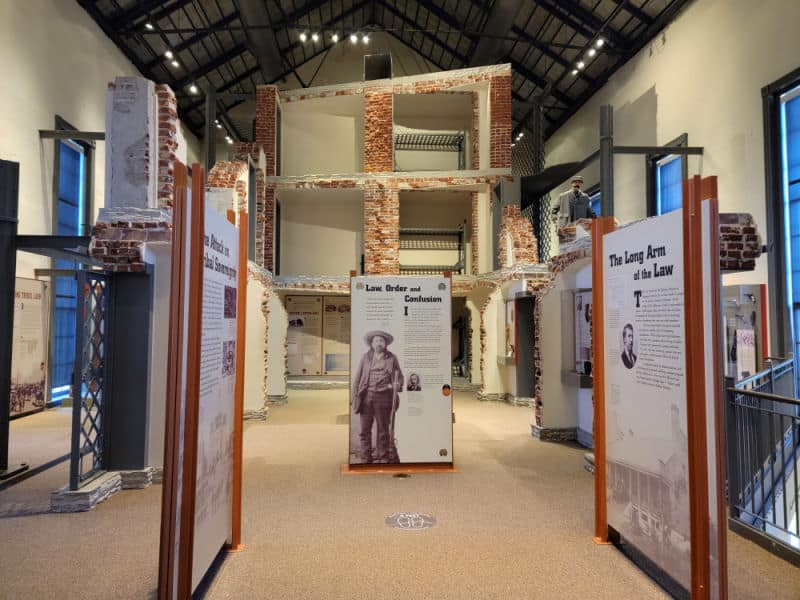
How to beat the crowds in Fort Smith National Historic Site?
We did not experience any large crowds while visiting the park. The grounds are large so it is easy to walk around any groups you may encounter.
Where to stay when visiting Fort Smith
There are no National Park Lodges within the park.
Wyndham Fort Smith City Center - 5 min walk from the park
You can look forward to a grocery/convenience store, a terrace, and a garden at Wyndham Fort Smith City Center. In addition to dry cleaning/laundry services and a bar, guests can connect to free in-room Wi-Fi.
Courtyard Marriott Fort Smith Downtown - 9 min walk from the park
Take advantage of a firepit, dry cleaning/laundry services, and a bar at Courtyard Marriott Fort Smith Downtown. Free in-room Wi-Fi is available to all guests, along with a 24-hour gym and a 24-hour business center.
Comfort Inn & Suites Fort Smith I-540
Hotel near the airport. You can look forward to a free breakfast buffet, dry cleaning/laundry services, and a health club. Stay connected with free in-room Wi-Fi, and guests can find other amenities such as a 24-hour business center.
Click on the map below for additional vacation rentals and lodging options in Fort Smith.
Camping
There are no National Park Campgrounds within the park.

For a fun adventure check out Escape Campervans. These campervans have built in beds, kitchen area with refrigerators, and more. You can have them fully set up with kitchen supplies, bedding, and other fun extras. They are painted with epic designs you can't miss!
Escape Campervans has offices in Vancouver, Seattle, Portland, San Francisco, Las Vegas, Los Angeles, Phoenix, Salt Lake City, Denver, New York, and Orlando
Parks Near Fort Smith National Historic Site
Pea Ridge National Military Park
Chickasaw National Recreation Area
Wilson Creek National Battlefield
President William Jefferson Clinton Birthplace Home
Check out all of the Arkansas National Parks and neighboring National Parks in Texas, Missouri National Parks, Louisiana National Parks, Oklahoma National Parks, Tennessee National Parks, and National Parks in Mississippi
Check out all of the US National Historic Sites
Don't miss all of the epic things to do in Fort Smith, Arkansas!
Make sure to follow Park Ranger John on Facebook, Instagram, Pinterest, and TikTok

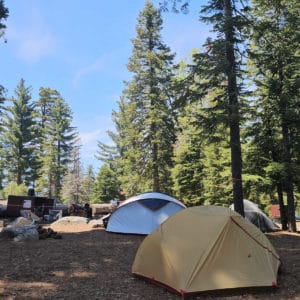
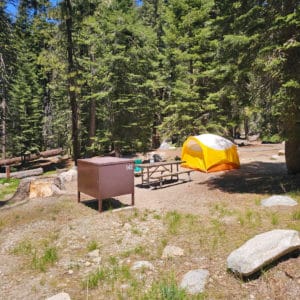
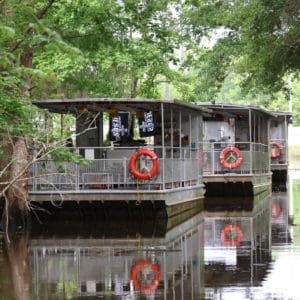

Leave a Reply